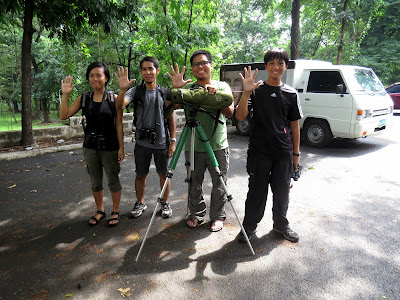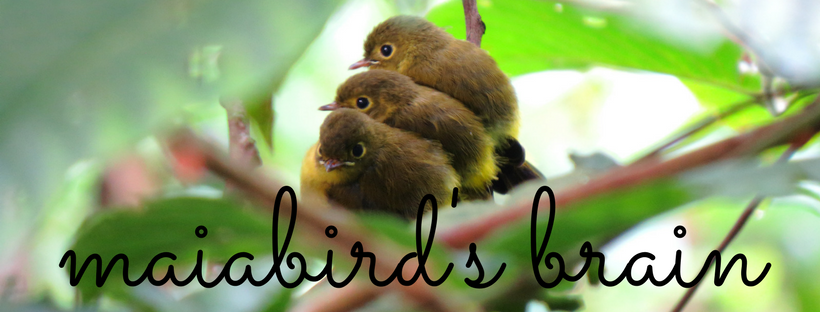Recently, the club organized a much smaller bird race for first-time birders in the UP Diliman Campus for the Pledge2Fledge campaign. It was a fun change from the usual guided birdwatching trip, creating friendly competition among the bird guides as well. I had to sit that one out as I had to stay at the parking lot and wait for the teams to come back. Jops was able to guide a small group and they finished second =)
 |
| Jops's team got second place with 20 species seen |
Our friend Jon J. organized a similar bird race for his 8th grade advisory class and I was excited to participate. It would be my first ever bird race! We would be having the bird race in the La Mesa Ecopark and would be birding for two hours only. Jops and I had to split to lead two teams of 7 students each. I got to lead the Team Earth with our birder friend, Jelaine, Jops led Team Water, Jon led Team Fire, and Fredd and Linda led Team Wind.
We walked towards the mini-forest but immediately spotted some White-breasted Wood-swallows, a Whiskered Tern, some Brown Shrikes, and Coppersmith Barbets even before passing the bridge! The other teams caught up with us so we pushed forward to the trail.
We checked out the area where the Indigo-banded Kingfishers frequent but they weren't there. Instead, our team saw Pied Fantails, Lowland White-eyes, a Philippine Pygmy Woodpecker, and a noisy Oriental Magpie Robin. A Barred Rail also crossed our path, with the students initially thinking it was a chicken =)
Jon's team arrived at the trail and when they veered towards the right, our team decided to turn left. Jelaine and I asked our team to move very carefully and to watch for ANY movement... and movement they saw! The three boys in front of us abruptly stopped and whispered "Movement!!!" There, a few feet in front of them, was the male Spotted Wood-Kingfisher! I told them to backtrack a bit slowly so as not to flush the bird. I trained the scope on the bird and enjoyed all the stifled gasps, oohs, ahhs, and ohmygods as the kids observed the kingfisher up close.
 |
| One of our team members, Larkin, even sketched the bird as he observed it through the scope! |
 |
| I didn't bring my camera so all I got was a blurry digiscoped photo using my phone's camera |
Jon's team eventually caught up with us and we backed up the trail to let him and his team see the kingfisher. Jops and his team also arrived and after pointing out the bird to them, Team Earth left the area to find more birds. We bumped into the fourth team led by Fredd and Linda and told them about the Spotty. They told us they just saw the Indigo-banded Kingfisher and our team went to spot it. The female IBKF was perched on a very low broken stump unmindful of its audience. When everyone had their fill of the bird, we ventured into the trail where we saw an immature Red-bellied Pitta hopping around, pulling out worms from the muddy ground.
Our last stop was the spillway where the kids saw a Grey Heron perched atop a tree, as well as some Little Egrets and a Common Sandpiper. As we were leaving the area, we got to add a Black-naped Oriole and Blue-tailed Bee-eaters to our list! We regrouped in the huts that Jon had rented out for the day and made our bird lists.
 |
| Announcing the winners! |
After tallying and summarizing the bird lists (and psyching out the other teams), Jon announced that our team, the Earth Team, saw the most number of species that morning! We won first place with 24 species seen! Not bad at all for two hours birding.
 |
| Earth Team: Jay, Lance, Mik, Ashley, Carlo, Larkin, me, Tricia, and Jelaine |
I was pretty amazed at the bird list we ended up with. We didn't even count the Ashy Ground Thrush in our list as not everyone saw it (part of the rules is that everyone in the team should see the bird for it to count.) We also missed out on some usual suspects like the Collared Kingfisher, Golden-bellied Flyeater, Mangrove Blue Flycatcher, Olive-backed Sunbird, Colasisi, and White-eared Brown-Dove! That would have upped our list to 31!
The birds lists were all quite long too with Jops's team finishing second with 23 species seen, just one bird shy of our team! I had a lot of fun in my first bird race. More than the fun, it made me realize that I have been overlooking all these "common" birds and have been "target birding" for the past few birding trips. Joining the race and guiding the kids made me appreciate all 24 (25) species we saw and it sort of refreshed me as a birder. We ended our morning with Jon and his class with lunch in the park, under the perch of a handsome Grey-streaked Flycatcher. I missed seeing this bird too =)
 |
| Happy birthday again, Jon! Your students are lucky to have you as their adviser (and this cake they gave you is evidence that they love you!) |


























